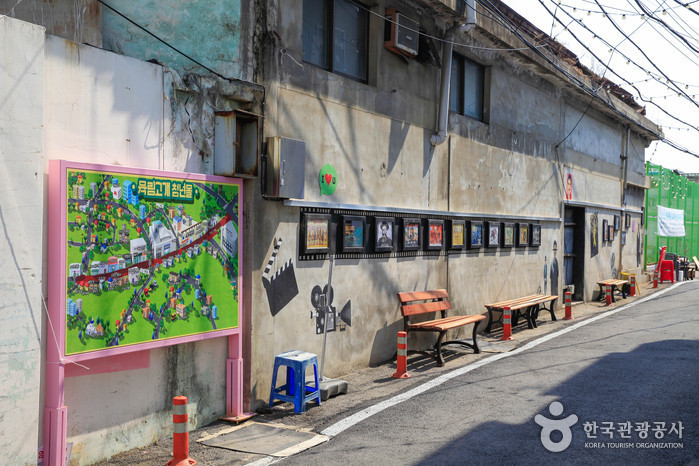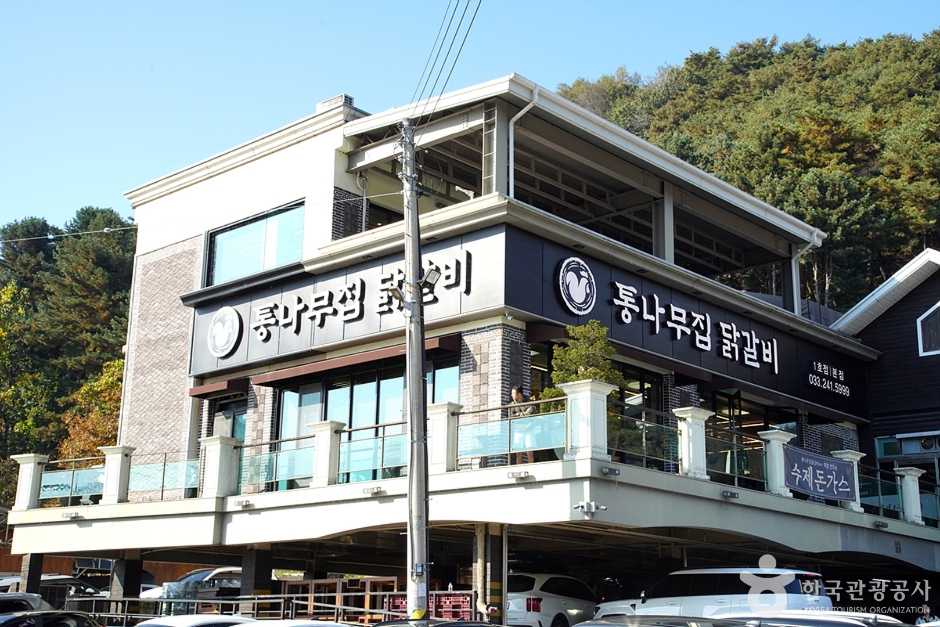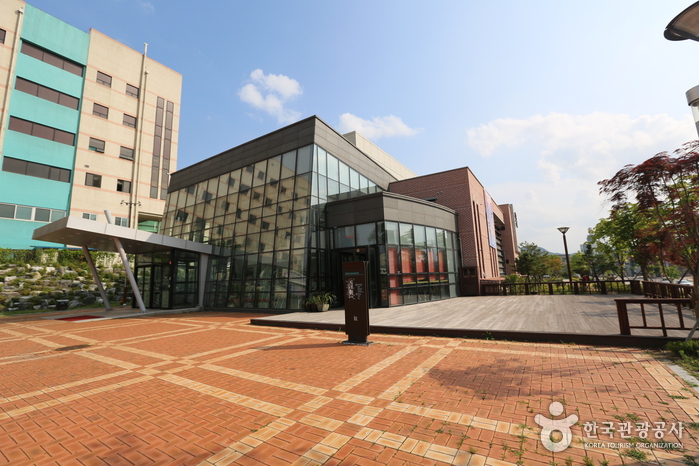Superior - Chuncheon M Department Store Branch [Tax Refund Shop] (슈페리어 골프앤스포츠 춘천M백화점)
13.0Km 2024-06-27
68-9, Geumgang-ro, Chuncheon-si, Gangwon-do
-
Chuncheon Myeongmul Dakgalbi (춘천명물닭갈비)
13.0Km 2024-03-20
813 Yetgyeongchun-ro, Chuncheon-si, Gangwon-do
Chuncheon Myeongmul Dakgalbi, a specialty restaurant renowned for dakgalbi (spicy stir-fried chicken), is situated near the scenic Bukhangang River and Uiamho Lake. Chuncheon is celebrated as the city of dakgalbi. Their signature dish features spicy seasoned chicken stir-fried with vegetables, tteok (rice cake), and sweet potatoes on an iron plate, offering an exquisite flavor. Notable nearby attractions include the Samaksan Cable Car and the MBC Broadcasting Station.
Yukrimgogae (육림고개)
13.1Km 2021-08-09
21-2, Chuncheon-ro 151beon-gil, Chuncheon-si, Gangwon-do
Yukrimgogae was the street that connected Yurim Theater (now closed) and Chuncheon Jungang Market in the past, becoming an unofficial downtown during 1980s to the 1990s. After the new city project, the stores relocated to the new downtown, leaving the area empty. In 2015, the street was rejuvenated with Makgeolli Street and Youth Mall. The street is full of restaurants and stores that was renovated providing an analog-feel combined with a trendy style.
Davich Optical - Chuncheon Branch [Tax Refund Shop] (다비치안경 춘천)
13.2Km 2024-06-26
90, Geumgang-ro, Chuncheon-si, Gangwon-do
-
Chuncheon Tongnamujip Dakgalbi (춘천통나무집닭갈비)
13.2Km 2024-03-20
763 Sinsaembat-ro, Sinbuk-eup, Chuncheon-si, Gangwon-do
Chuncheon Tongnamujip Dakgalbi, a Korean restaurant situated on Dakgalbi Street near the Soyanggang Dam, has been serving customers since 1978. This establishment has two branches: the first specializes in dakgalbi (spicy stir-fried chicken) grilled on a hot iron plate, while the second features charcoal-grilled dakgalbi. It is renowned for its savory Sogeum gui dakgalbi (grilled salted chicken) and sweet Ganjang dakgalbi (stir-fried chicken with soy sauce), offering visitors a delightful dining experience in an environment blessed with clean water and fresh air.
Chuncheon Makguksu & Dakgalbi Festival (춘천 막국수닭갈비축제)
13.2Km 2022-12-29
245 , Sports town-gil, Chuncheon-si, Gangwon-do
• 1330 Travel Hotline: +82-2-1330 (Korean, English, Japanese, Chinese) • For more info: +82-33-254-4347
Chuncheon Makguksu & Dakgalbi Festival celebrates dakgalbi (spicy stir-fried chicken) and makguksu (buckwheat noodles), two of the most famous specialties of the city of Chuncheon. During this festival, the area is full of booths selling buckwheat noodles and spicy stir-fried chicken. The festival offers plenty of ways to experience these two local foods.
Chuncheon Samaksan Mountain Lake Cable Car (춘천 삼악산 호수케이블카)
13.2Km 2024-10-24
245 Sports town-gil, Chuncheon-si, Gangwon-do
Samaksan Mountain Lake Cable Car is the longest cable car in Korea, which connects Samcheon-dong and Samaksan Mountain across Uiamho Lake. The 20 Crystal Cabins among the 66 total cabins offer the best choice to enjoy the beautiful Uiamho Lake and Samaksan Mountain. Samaksan Lake Cable Car Building, which resembles a bow and boomerang, has a variety of amenities. There are restaurants, convenience stores, cafés, and souvenir shops at Uiamho Lake Stop (lower stop). Visitors can enjoy the beautiful view of Chuncheon with a cup of tea at the café at Samaksan Mountain Stop (upper stop).
Kolping - Chuncheon Branch [Tax Refund Shop] (콜핑 춘천)
13.2Km 2024-06-26
100, Geumgang-ro, Chuncheon-si, Gangwon-do
-
Festival Theater Mime (축제극장 몸짓)
13.5Km 2021-03-17
112, Chuncheon-ro, Chuncheon-si, Gangwon-do
+81-33-259-5880
Festival Theater Mime in Chuncheon, Gangwon-do is a modern four-story performance hall, with one basement floor and three above-ground floors. Believing that human gestures can change the world, the theater features a wide repertoire of inspiring performances involving traditional music, dance, drama and mime.
Chuncheon Cheongpyeongsa Temple (청평사 (춘천))
13.5Km 2023-05-22
810, Obongsan-gil, Chuncheon-si, Gangwon-do
+82-33-244-1095
Cheongpyeongsa Temple is a Buddhist temple with 1,000 years of tradition, located at Obongsan Mountain. Originally established as Baegamseonwon Temple in 973, the temple changed its name several times, went through construction works, and has become the current Cheongpyeongsa Temple. Yi Ja-hyeon, a scholar of the Goryeo period, built a garden here by keeping its natural topography after he left his government post. In this area, there is a pond that was built during the Goryeo period and has preserved its original form. Many cultural heritages have disappeared over the years and during the Korean War as well. The remaining cultural heritages include Hoejeonmun Gate of Cheongpyeongsa Temple (Treasure No. 164), Three-story Stone Pagoda of Cheongpyeongsa Temple (Gangwon-do Cultural Heritage Material No. 8), and Stupa of Yi Ja-hyeon (posthumous epithet: Jillakgong). Cheongpyeongsa Temple’s Hoejeonmun Gate was built instead of Sacheonwangmun Gate (the gate of the Four Guardian Kings) to enlighten people about the transmigration of souls. Cheongpyeongsa Temple bears a myth about a princess and a serpent. The princess suffered a lot from a serpent as she couldn’t get rid of it from her body. Then she came to Cheongpyeongsa Temple and prayed to the Buddha, and she became free from the serpent. Therefore, the Three-story Stone Pagoda of Cheongpyeongsa Temple is also called “Princess Pagoda.” Although the scale of the temple is not large, it is known for its beautiful natural landscape harmonized with artificial structures, such as a pavilion and a pond. Accordingly, the temple area was designated as Scenic Site No. 70. Cheongpyeongsa Temple can also be reached by taking a ferry at the Soyanggang Dam Quay.
![Superior - Chuncheon M Department Store Branch [Tax Refund Shop] (슈페리어 골프앤스포츠 춘천M백화점)](http://tong.visitkorea.or.kr/cms/resource/53/3313553_image2_1.jpg)


![Davich Optical - Chuncheon Branch [Tax Refund Shop] (다비치안경 춘천)](http://tong.visitkorea.or.kr/cms/resource/94/3312994_image2_1.jpg)

![Kolping - Chuncheon Branch [Tax Refund Shop] (콜핑 춘천)](http://tong.visitkorea.or.kr/cms/resource/99/3313099_image2_1.jpg)

 English
English
 한국어
한국어 日本語
日本語 中文(简体)
中文(简体) Deutsch
Deutsch Français
Français Español
Español Русский
Русский